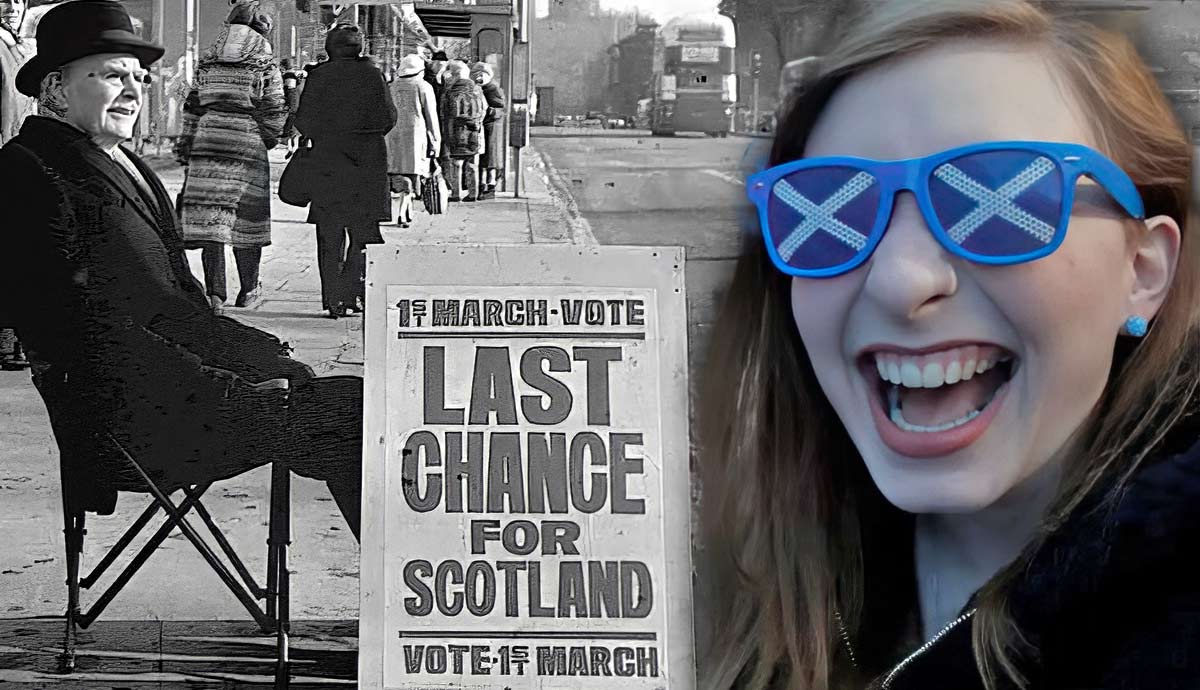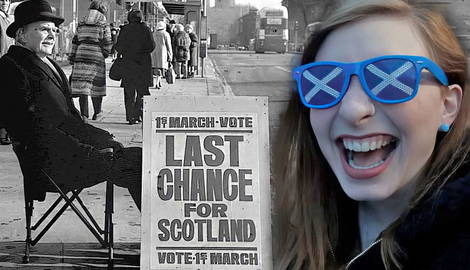
To say that Scotland’s relationship with England has been troubled would be an understatement. Forced to live next to each other because of geography and forced to get along because of the Acts of Union in 1707, the Scottish have resented the English for reasons that go back many centuries.
For the Scottish, these reasons are valid, but for some, they are relics of the past. For others, they matter today and add emotional value to a pragmatic desire to break free from the United Kingdom, or what they see as English domination, thus pulling Scotland onto a path that does not bode well for the country.
Digging into the real history between the two nations uncovers an unsurprising history of arrogance and abuse. It becomes clear why Scotland has, through the ages, sought to break free from its southern neighbor.
Scottish Beginnings

During the Middle Ages, when England was embroiled in wars against the Danes, the Kingdom of Scotland emerged as an independent polity. Various dates could be given, but 843 CE, with the inauguration of Kenneth MacAlpin, who unified the Scots and the Picts, is generally accepted as the year the kingdom was founded.
From 943 onward, after the founding of the Kingdom of England, tensions would rise between the two nations, generally over the level of independence the English felt the Scottish deserved. To make matters more complicated, Scottish nobles also fought over this dynamic, as some were loyal to England.
The Scottish Wars of Independence

The first major series of events that defined the nature of the Scottish question of independence was the Scottish Wars of Independence which raged from 1296 to 1328. These events were kickstarted by the death of the king of Scotland, Alexander III, who fell off his horse in 1286 and died.
The heir to the throne was his granddaughter, Margaret, who was then promised to be married to Prince Edward of Caernarvon, the son of the English king, Edward I. Despite this promise, the Scots declared that it did not signify a marriage between Scotland and England and that Scotland’s rights as a separate kingdom were sacrosanct. Margaret, however, died from an illness in 1290 while traveling from Norway to Scotland. She was only seven years old at the time. With no clear line of succession, the kingdom fell into a period of interregnum, and no less than 13 men laid claim to the throne.
The two men with the most powerful claim were John Balliol and Robert Bruce, the latter being the grandfather to the future king, Robert the Bruce. Fearing a descent into civil war, the Guardians of Scotland asked Edward I to mediate and help come to a decision of who the rightful heir to the Scottish throne would be. Before he made his decision, Edward demanded that the Scottish lords recognize him as Lord Paramount of Scotland, to which they acceded. Edward I found in favor of John Balliol, who subsequently ruled as a puppet under Edward I.

The English king treated Scotland as a vassal state and refused to treat Scotland as an equal. Distressed by this, dissent rose among the Scottish nobles, and King John made an alliance with France (the Auld Alliance), which infuriated King Edward so much that he invaded Scotland. In 1296, English forces sacked Berwick and soundly defeated the Scots at Dunbar.
King John was stripped of his kingship, and Edward took the Stone of Scone, among many other symbols of Scottish nationhood.
The period of English dominion would not last, however. Rebellions erupted, led by William Wallace and Andrew Moray, who led the Scots to victory at Stirling Bridge. Moray died from his wounds incurred during the battle, and Wallace was made Guardian of Scotland. The English struck back, however, and won a significant victory at Falkirk. Soon after, they captured Wallace and executed him, turning him into a martyr for the Scottish cause.
As claimants to the Scottish throne, Robert the Bruce and John Comyn were named the new Guardians of Scotland, and Scotland seemed to have been subdued for a time, but again, the situation erupted into war. Robert the Bruce murdered John Comyn in Greyfriars Kirk during an argument in which it seems Comyn had informed Edward of Robert’s intention to become king. Bruce and Comyn had had an agreement whereby one of them would renounce their claim and, in return, receive lands from the other. By betraying Bruce, Comyn had sought to retain his lands as well as his claim to the throne.

With Comyn out of the way, Robert the Bruce was crowned, and he rallied support for a renewed attempt to break free from English dominion. The Scots slowly gained ground against the English, winning pivotal battles such as Louden Hill and Bannockburn. By 1318, the English had been expelled from all Scottish lands, and the Scots affirmed their independence by signing the Declaration of Arbroath in 1320, which was presented to the pope. The English refused to recognize the declaration until 1328 after years of cross-border raids by the Scots into English lands.
Robert the Bruce died the next year, and the king of England, Edward III, renewed the English attempt to subjugate the Scots. He was aided by a number of Scottish noblemen loyal to the English cause. Leading them was Edward Balliol, the son of John Balliol and a claimant to the Scottish throne. With a few thousand men, the noblemen invaded Scotland and defeated the Scottish army at Dupplin Moor, thus clearing the path for Edward Balliol to be crowned, supplanting the power of the young King David II.
The Guardian of Scotland, Sir Archibald Douglas, made a truce with Balliol with the intention of convening a parliament to decide the legitimacy of Balliol’s claim, but when Balliol declared that Scotland had always been a fief of England and that he would give land to the English for supporting his claim, Douglas attacked Balliol’s forces and drove him out of Scotland. The resultant counterattack by a large English army saw much of Scotland under English control. The English ravaged the Scottish lands while the Scottish forces, massively outnumbered, avoided pitched battles.
King James, Union, & More Conflict

In 1603, by right of inheritance, King James VI of Scotland also became James I of England. He was Henry VII’s great-great-grandson. Through his descendants, the status of England and Scotland being ruled by a single monarch lasted until 1688 when James II and VII was deposed in the Glorious Revolution of 1688. This came amid great tensions between Catholics and Protestants; he was the last Catholic king of both countries.
When Queen Anne became the monarch, she sought greater integration of the two nations, and the Articles of Union, ratified in 1707, created the Kingdom of Great Britain, formally uniting Scotland and England into a single kingdom. This was not without resistance, but instead of the focus being on Scottish independence, the focus became a conflict for the crown of the entirety of Great Britain. Thus, the Jacobite movement started, which sought the restoration of the senior line of the House of Stuart to the British throne. Although the conflict was over the right to the crown, it was seen very much as a movement associated with Scottish nationalism and an attempt to gain power over England.
The Jacobite movement was finally put to an end in 1746 when a British army completely destroyed the Jacobite army at the Battle of Culloden.
The Home Rule Movement

Starting in 1843, the Home Rule Movement began to gain traction. The British union with Ireland spurred this movement on, as the English treatment of the Irish outraged many Scots who felt the English regarded them with the same contempt. The movement was supported in the early 20th century by Prime Minister H.H. Asquith, who believed in a more federalized version of the United Kingdom where the countries that made up the union had greater autonomy in their own affairs. The movement was, however, scuppered by the need to focus on fighting a world war with Germany.
The movement came back into prominence during the 1960s as the decolonization of Africa saw a wave of anti-imperialist sentiment sweep across the United Kingdom. Scotland again began questioning whether it needed to be in a union with England.
Devolution

The discovery of North Sea oil invigorated the movement for Scottish independence. Had Scotland been independent and had the right to the oil in its own waters, it would have led to Scotland having one of the strongest currencies in Europe. The need for union was greatly reduced, and the Scottish National Party began attracting a huge following. In 1979, a referendum was held for the creation of a Scottish Assembly, but it failed to garner the required support. It wasn’t, however, the end of the democratic attempts for independence.
The question of independence was revisited in 1997. This time, the idea was that Scotland would have a devolved parliament through which they could administer greater autonomy while still being part of the United Kingdom.
For many Scots, this was a tricky question, as they were unsure what would result in the creation of a devolved parliament. Those who wanted full independence were worried because of the possibility that once devolution had been secured, the desire for full independence might disappear. Others saw devolution as a necessary step towards independence.
The referendum, however, was a success for those seeking independence from governance from Westminster, and Scotland opened its first parliamentary session in 1999 for the first time since 1707.
Scottish Independence Movements: 2014 & Beyond

After the Scottish National Party won a majority in the Scottish Parliament in 2011, another referendum on independence came to fruition amongst renewed sentiment among the Scottish people. Negotiations and debates were promptly held on the future of Scotland, either as an independent nation or an entity of the United Kingdom. Public opinion seemed evenly split, and when the Scots went to the polls, they did so en masse, with a voter turnout of 84.6%.

The majority of them, however, voted to remain part of the United Kingdom, and it seemed like the question of Scottish independence was finally put to rest. Brexit, however, created a massive surge in Scottish independence only two years later. The majority of Scots (62%) voted to remain in the European Union, so they found themselves at odds with the wishes of their southern neighbor, which voted to leave the EU. This dynamic has also brought into more prominence the future of Northern Ireland, and sentiment there regarding Irish re-unification is also becoming an issue that cannot be avoided for much longer, especially as support for Sinn Fein grows.
Among the legal challenges of holding another referendum, sentiment in the years since 2014 has shifted back and forth.

The question of Scottish independence is far from over. Carrying on the long tradition of wanting to be separate from the English, Scottish nationalists continue their quest, albeit in a less bloody manner and within a more legal framework.










